Top 10 Competitive Intelligence Tools for Sales

Top 10 Competitive Intelligence Tools for Sales
Competitive intelligence tools are essential for sales teams looking to outpace competitors and close more deals. These platforms provide real-time insights into competitor activities, market trends, and buyer behavior, helping sales professionals make data-driven decisions. From tracking pricing changes to delivering AI-powered battlecards, the right tool can increase win rates by up to 15% and reduce sales cycles by 20%.
Here’s a quick overview of the top tools covered:
Insightsfirst: AI-driven insights, custom dashboards, and expert consultant support.
Kompyte: Real-time alerts, dynamic battlecards, and win/loss analysis.
Crayon: Automated battlecards, win/loss analysis, and 100+ data types monitored.
Brandwatch: Social listening, sentiment analysis, and trend detection.
Highspot: AI-powered sales enablement with dynamic playbooks.
Apollo.io: Prospecting, outreach automation, and data enrichment.
ZoomInfo: Buyer intent tracking and extensive company data.
Similarweb: Website traffic analysis and competitor benchmarking.
Meltwater: Media monitoring and social analytics.
Owler Max: Company profiles, real-time alerts, and relationship mapping.
Quick Comparison
| Tool | Key Features | Starting Price (USD) | Integrations | Best For |
|---|---|---|---|---|
| Insightsfirst | AI insights, custom dashboards | Custom quote | Salesforce, HubSpot | Predictive intelligence |
| Kompyte | Alerts, dynamic battlecards, analysis | Custom quote | Salesforce, Slack | Real-time tracking |
| Crayon | Automated battlecards, data tracking | Custom quote | Salesforce, Slack | Competitive insights |
| Brandwatch | Social listening, sentiment analysis | ~$800/month | Salesforce, HubSpot | Social monitoring |
| Highspot | AI playbooks, sales enablement | Custom quote | Salesforce, Microsoft | Sales workflows |
| Apollo.io | Prospecting, automation, enrichment | $49/month per user | Salesforce, HubSpot | Affordable prospecting |
| ZoomInfo | Buyer intent signals, company data | Custom quote | Salesforce, HubSpot | U.S. market insights |
| Similarweb | Traffic analysis, benchmarking | $199/month | Salesforce, HubSpot | Digital intelligence |
| Meltwater | Media monitoring, trend analysis | ~$4,000/year | Salesforce, Slack | Media and social trends |
| Owler Max | Alerts, relationship mapping | ~$99/month per user | Salesforce, HubSpot | Detailed company tracking |
These tools cater to different needs, from monitoring social sentiment to delivering AI-driven competitive insights. Choose based on your team's priorities, budget, and integration preferences.
How to use sales and competitive intelligence to win bigger deals and scale growth
::: @iframe https://www.youtube.com/embed/1qt1fmzKO34 :::
1. Insightsfirst
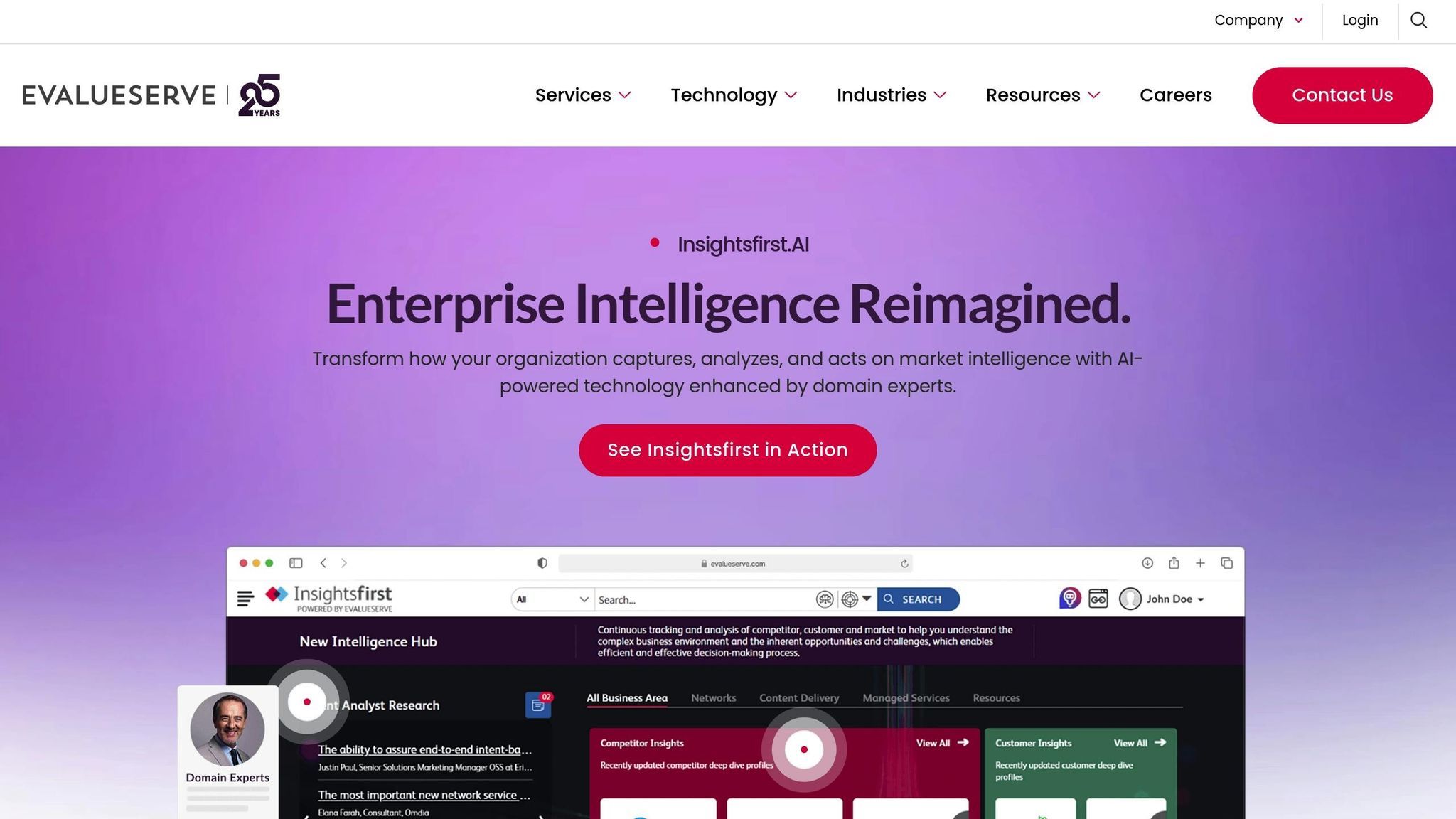
Insightsfirst is an AI-driven research assistant designed to revolutionize how sales teams handle competitive intelligence. Instead of merely monitoring competitors, it processes vast amounts of data and pinpoints the most relevant insights, helping teams anticipate market changes before their rivals. This forward-thinking approach sets the stage for the advanced features outlined below.
Sales teams using Insightsfirst have seen tangible results: a 30% boost in efficiency thanks to streamlined data access, with some organizations reporting a 25% jump in lead conversion rates after adopting the platform [1].
Key Features for Competitive Intelligence
Insightsfirst stands out with its powerful tools for competitive intelligence, offering features that simplify and enhance data analysis:
Searchable Repository: A centralized space where insights are stored and organized for quick and easy access.
AI-Powered Insights Engine: Automatically tracks competitor actions, market signals, and industry trends, saving teams from the hassle of manual monitoring. Custom dashboards highlight the most critical intelligence, tailored to your needs.
Expert Consultant Support: Beyond automated analysis, Insightsfirst enlists a team of seasoned consultants to add context, validate findings, and offer strategic guidance. This blend of AI precision and human expertise ensures that insights are actionable and directly contribute to sales strategies.
In January 2024, a SaaS company in the U.S. adopted Insightsfirst and saw a 40% improvement in their competitive analysis efficiency within three months. Their Sales Operations Manager, John Doe, streamlined data collection and reporting using the platform, driving a 20% increase in sales during the first quarter post-implementation.
Pricing (in USD)
Insightsfirst takes a personalized approach to pricing, tailoring costs to match each business's unique needs. Instead of fixed tiers, they evaluate factors like team size, required features, and integration needs to provide a custom quote in U.S. dollars.
For businesses in the U.S., this flexible pricing ensures a solution that aligns with both usage patterns and budgets, making it a practical choice for companies with specific requirements.
Integrations with Sales and Marketing Tools
While Insightsfirst doesn’t provide a public list of integrations, it works seamlessly with major CRM platforms like Salesforce and HubSpot. This allows sales teams to access competitive insights directly within their existing workflows, eliminating the need to juggle multiple tools during prospect conversations.
The platform also integrates with marketing automation tools, ensuring that competitive intelligence becomes a natural part of your broader go-to-market strategy.
Benefits for U.S.-Based Sales Teams
U.S. sales teams gain a competitive edge with Insightsfirst’s real-time, actionable intelligence. By combining AI-driven insights with expert analysis, the platform helps teams stay ahead of competitors and adapt quickly to market changes. This dual approach empowers sales professionals to craft compelling messaging that directly addresses competitive challenges.
2. Kompyte
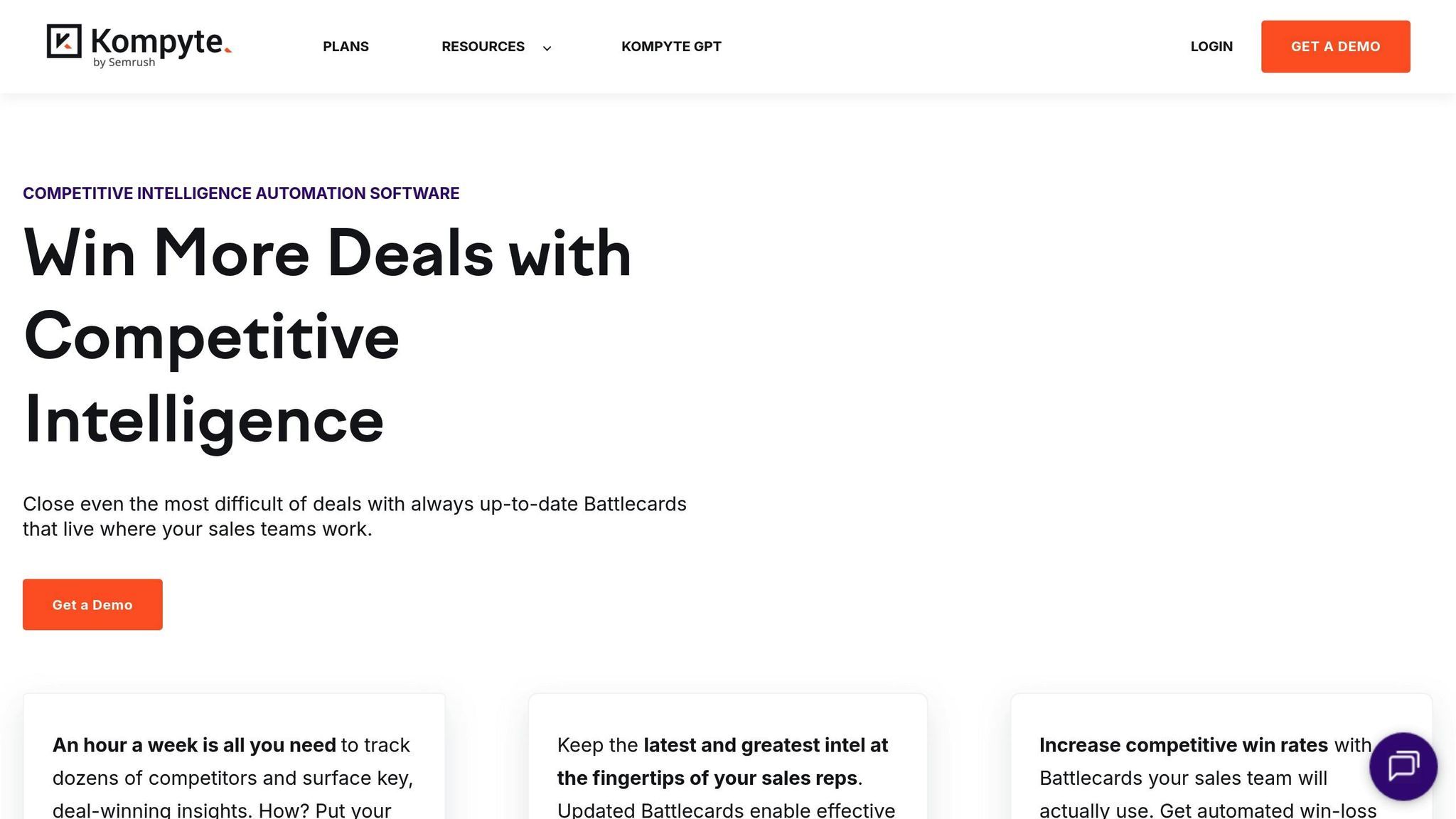
Kompyte acts like your digital assistant that never sleeps, keeping tabs on website updates, pricing changes, and product launches. This constant monitoring equips sales teams with the insights they need to stay ahead in competitive situations. It’s all about turning raw data into actionable information for closing deals.
Key Features for Competitive Intelligence
Kompyte’s automated system keeps a close watch on competitors by scanning websites, press releases, product pages, and marketing campaigns. The platform immediately notifies sales teams when there’s a shift in pricing, a new product launch, or a change in messaging [1].
One standout feature is its dynamic battlecards. These provide sales reps with up-to-date talking points, strategies for handling objections, and key differentiators - all integrated directly into their workflow. It’s a tool designed to keep sales reps informed and ready to respond in real time [1].
On top of that, Kompyte offers win/loss analysis and tailored sales content suggestions, helping teams understand what’s working (and what’s not) against specific competitors. This feedback loop encourages constant improvement.
For instance, a U.S.-based SaaS sales team used Kompyte to track frequent product updates and pricing shifts from a major competitor. By acting on real-time alerts and using updated battlecards, the team effectively addressed customer concerns and boosted their win rate by 15% within a single quarter [1].
Pricing (in USD)
Kompyte offers custom pricing tailored to the unique needs of each business. To get a quote, U.S. companies need to contact Kompyte directly, as pricing details aren’t publicly available [1]. The subscription cost depends on factors like team size, required features, and integration preferences.
Integrations with Sales and Marketing Tools
Kompyte integrates smoothly with widely used U.S. sales and marketing tools, such as Salesforce, HubSpot, and Slack. These integrations bring battlecards and alerts directly into CRM systems, ensuring competitive intelligence is always accessible when and where it’s needed [2].
Benefits for U.S.-Based Sales Teams
U.S. sales teams gain a significant advantage with Kompyte’s real-time insights. By staying informed on competitor moves - like pricing adjustments or new product launches - sales reps can tailor their pitches and address objections with confidence. This not only shortens sales cycles but also keeps teams ahead of the competition. Plus, the automated tracking eliminates the need for time-consuming manual research, allowing reps to focus on closing deals.
For businesses exploring AI-driven sales tools, resources like AI SDR Shop offer detailed comparisons of competitive intelligence features, helping U.S. companies choose the best tools for their sales strategies.
3. Crayon
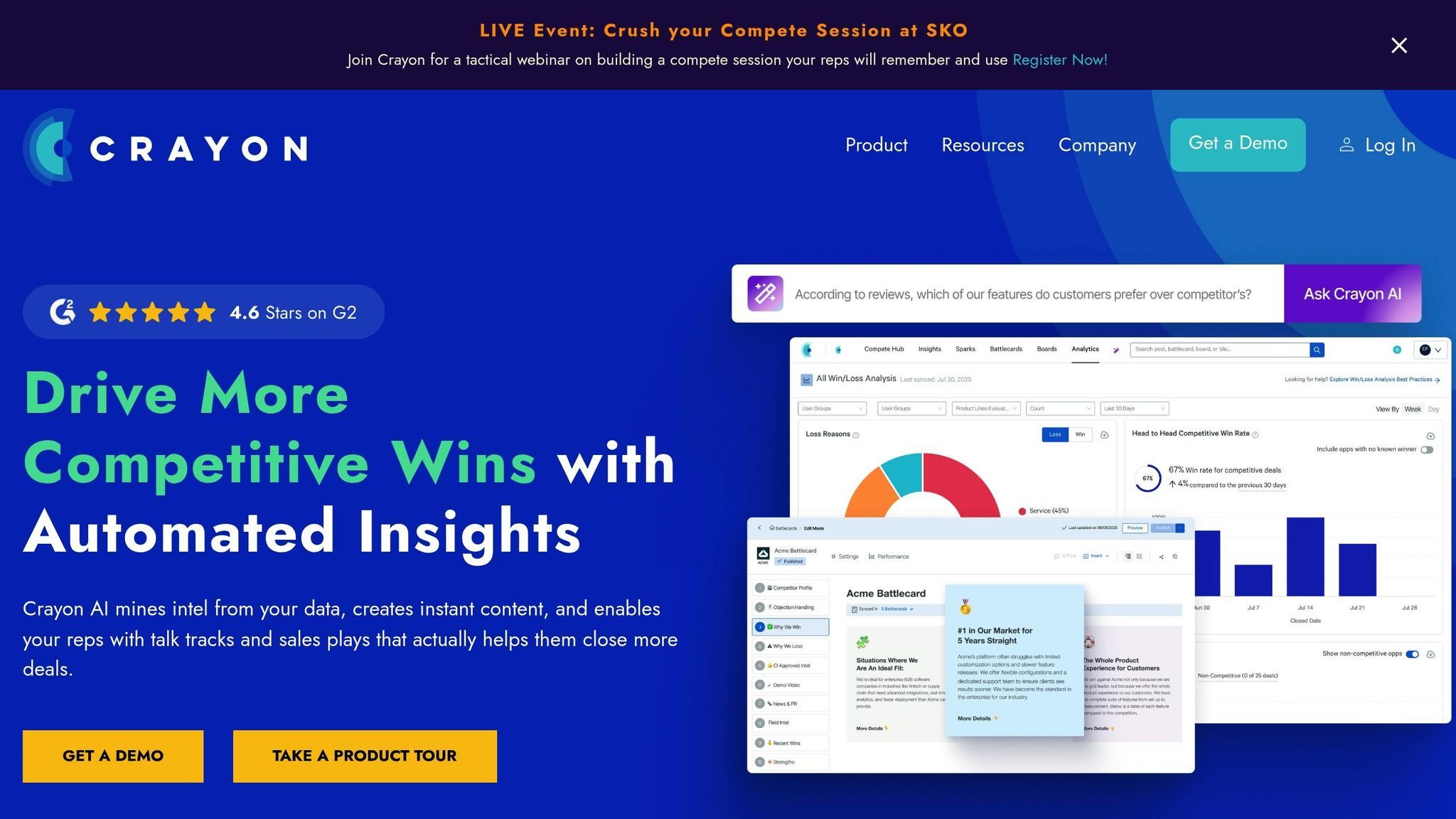
Crayon takes competitive intelligence to the next level by embedding AI-powered insights directly into your workflow. This approach transforms reactive data into actionable strategies, giving your sales team a proactive edge.
Key Features for Competitive Intelligence
Crayon monitors over 100 data types in real time, including pricing updates, messaging shifts, product launches, and strategic moves. Its AI-generated battlecards automatically update to provide sales reps with up-to-date, actionable talking points.
The platform also keeps a close eye on website changes, job postings, social media activity, and marketing campaigns. When competitors make critical moves, Crayon sends instant alerts along with strategic recommendations, ensuring your sales team can respond quickly and effectively. Additionally, its win-loss analysis captures valuable insights into why competitors are winning deals, helping revenue teams refine their messaging and sales strategies based on hard data.
Pricing (in USD)
Crayon uses a custom pricing model, so businesses need to contact them directly for a quote. While exact pricing isn’t disclosed, industry sources suggest that basic plans typically start at around $199 per month[6]. For enterprise-level needs, pricing is tailored to the scale and complexity of your competitive intelligence requirements.
Integrations with Sales and Marketing Tools
Crayon integrates seamlessly with key sales and marketing tools to enhance workflow efficiency. It connects deeply with Salesforce, embedding competitive intelligence directly into opportunity records so sales reps can access battlecards without leaving their workflow. The platform also integrates with Slack for real-time updates, Highspot for sales enablement, and Gong for conversation intelligence. These integrations create a unified system where competitive intelligence becomes a natural part of your sales and marketing operations, helping teams stay ahead of the competition.
Benefits for U.S.-Based Sales Teams
Crayon’s proactive intelligence delivery offers U.S. sales teams a clear advantage. Automated battlecard updates and instant alerts enable quick responses, while detailed win-loss analysis highlights why competitors are succeeding, allowing for precise strategy adjustments.
With strong integration into widely used U.S. tools like Salesforce, Crayon fits seamlessly into existing workflows. Its analytics and reporting align with American business standards, making it a practical choice for sales teams aiming to improve performance through data-driven decisions. By combining AI-driven insights with familiar tools, Crayon empowers teams to transform their sales processes.
For businesses evaluating sales enablement tools, AI SDR Shop provides in-depth comparisons to help you determine how solutions like Crayon can enhance your overall sales technology stack.
4. Brandwatch
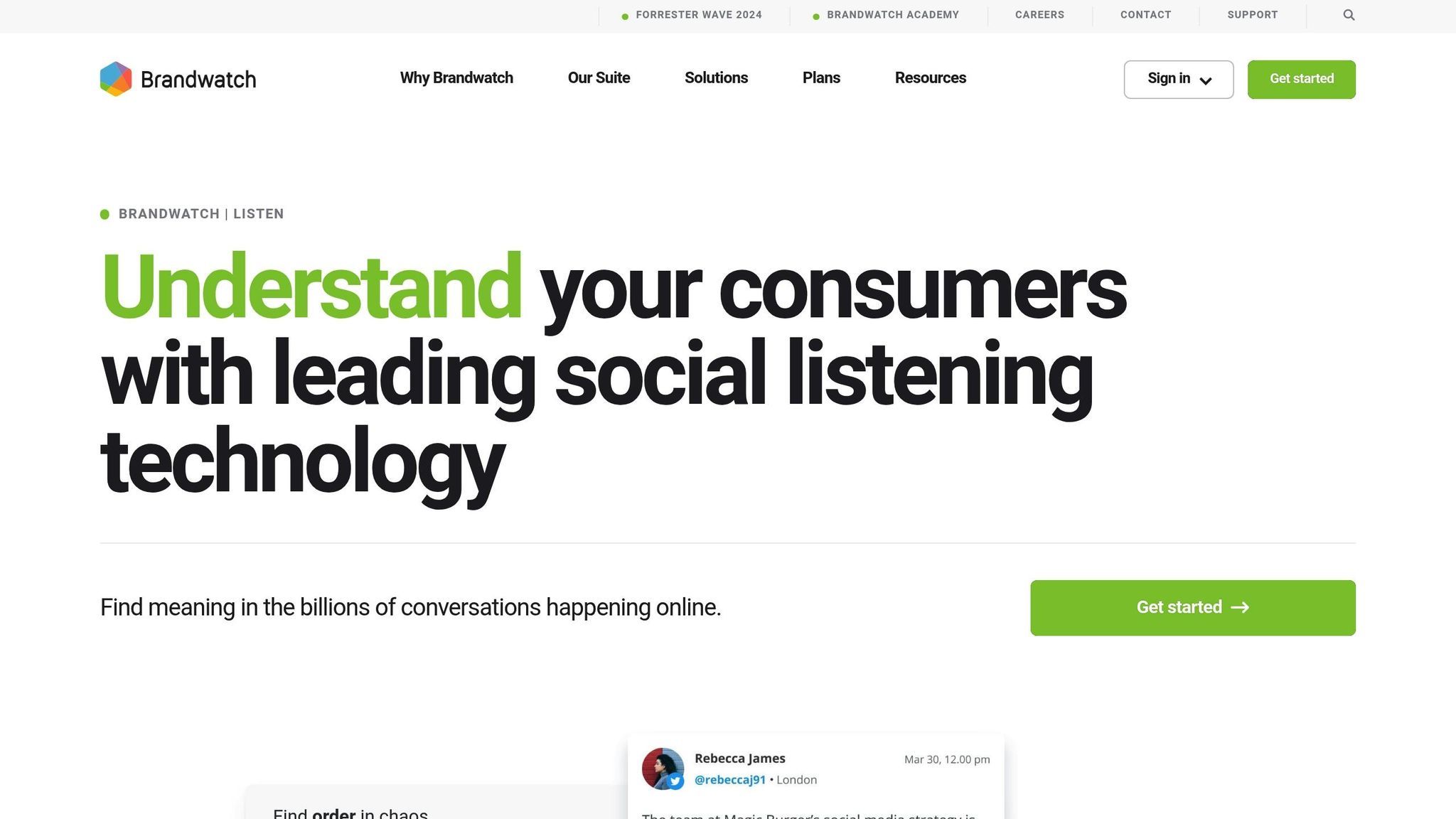
Brandwatch has established itself as a leader in social listening, transforming online data into actionable insights for competitive intelligence. By monitoring over 100 million online sources - ranging from social media platforms to news sites, blogs, and forums - it provides sales teams with a detailed view of competitor actions and market sentiment[8].
Key Features for Competitive Intelligence
With its AI-powered sentiment analysis, Brandwatch achieves over 90% accuracy for English-language content, making it especially effective for U.S. sales teams[8]. The platform sifts through billions of online conversations to reveal key insights about competitor strategies and consumer behavior.
One standout feature is its real-time competitor tracking. Sales teams receive immediate alerts when competitors roll out campaigns, introduce new products, or experience shifts in customer sentiment. Its trend detection tools also help identify emerging market opportunities before they gain widespread attention. Customizable dashboards allow teams to visualize metrics that align with their specific goals, while its influencer identification tools highlight the key voices shaping industry conversations. Pricing scales with business needs, ensuring access to the right level of insights for any team.
Pricing (in USD)
Brandwatch uses a customized pricing structure, tailored to the size and data requirements of your business. Entry-level plans start at approximately $800 per month, while enterprise-level packages can exceed $3,000 per month[8]. These plans typically include onboarding, ongoing support, and access to core analytics features. For teams that require extensive monitoring across multiple markets, higher-tier plans offer expanded data sources and advanced analytics tools.
Integrations with Sales and Marketing Tools
Brandwatch integrates seamlessly with many popular sales and marketing platforms. It connects directly with Salesforce, as well as marketing automation tools like HubSpot and Marketo, and collaboration platforms such as Slack and Microsoft Teams[1]. These integrations allow competitive insights to flow effortlessly into existing workflows. For instance, the Salesforce integration embeds real-time competitor intelligence directly into opportunity records, streamlining the sales process.
Benefits for U.S.-Based Sales Teams
Brandwatch offers distinct advantages for U.S. sales teams, including access to localized data sources and compliance with American data privacy standards[8]. Its comprehensive coverage of North American social and news platforms ensures teams stay informed about domestic market trends.
In June 2024, Coca-Cola North America highlighted Brandwatch’s impact during a competitive summer beverage launch. By analyzing over 2 million social media mentions and news articles, the company identified emerging consumer preferences and adjusted its messaging. This approach led to a 12% increase in campaign engagement and a 7% boost in sales over three months[8].
"The project was led by Digital Marketing Director Lisa Grant and documented in Brandwatch's official case studies" [8]
For sales teams focused on agility, Brandwatch’s real-time monitoring enables quick adjustments to messaging and proactive objection handling. When competitors make significant moves, teams can pivot their strategies based on solid data instead of guesswork.
With a 4.5/5 rating on G2 from over 1,200 reviews, users frequently praise Brandwatch for its data accuracy and customizable dashboards[8]. This reliability makes it a trusted tool for sales teams looking to make informed, impactful decisions.
5. Highspot
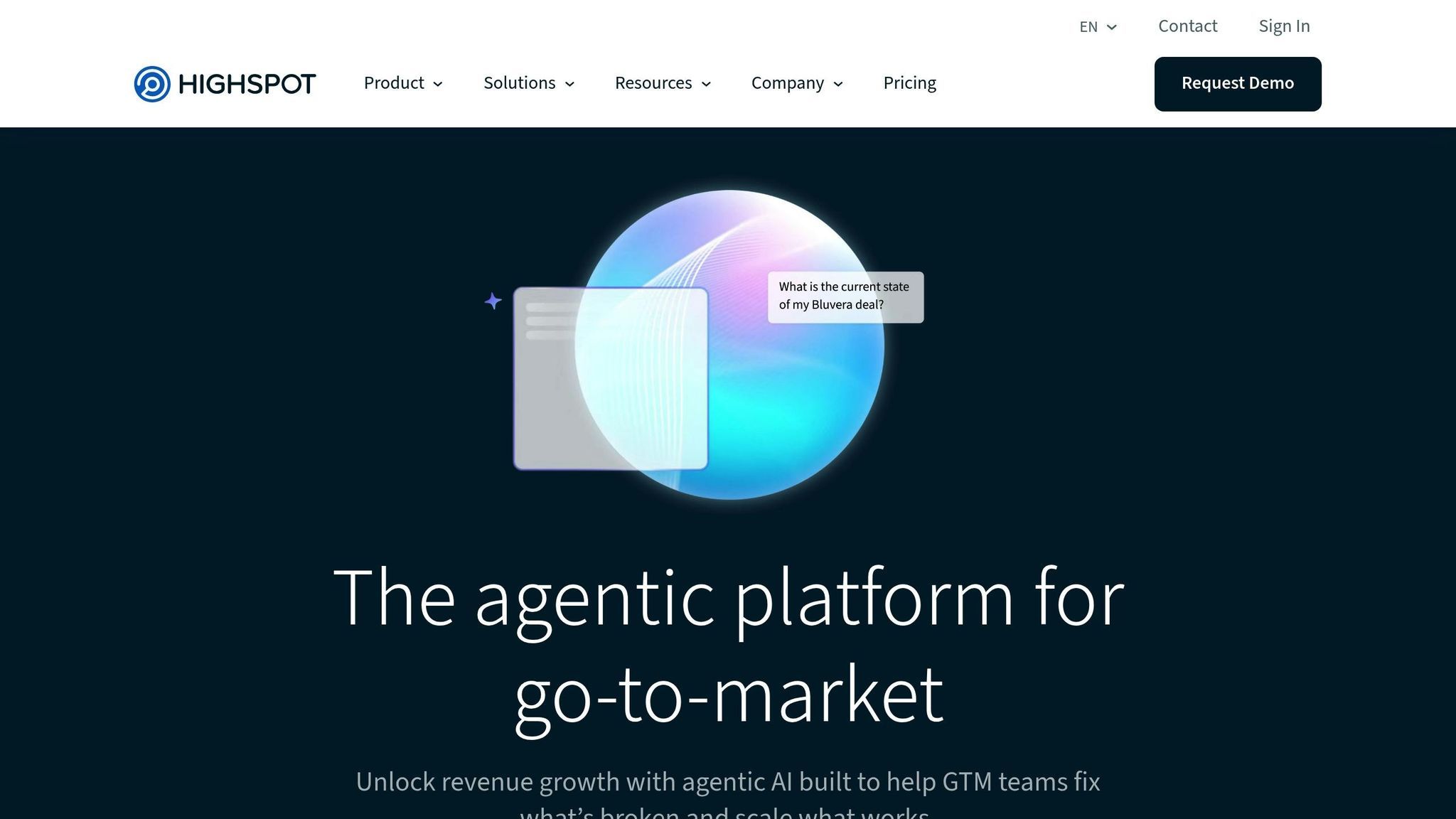
Highspot takes sales enablement to the next level by embedding real-time competitive insights directly into your sales process. Unlike tools that simply monitor competitors, Highspot integrates these insights into your team's daily workflow. This means sales reps can effortlessly access battlecards, objection-handling scripts, and market intelligence exactly when they need them, streamlining the way they tackle competitive challenges.
Key Features for Competitive Intelligence
Highspot's battlecards provide a quick and effective way for sales reps to compare their offerings against competitors. These cards are packed with the latest details on strengths, weaknesses, and proven strategies for addressing objections, ensuring teams are always prepared when engaging with prospects [2].
The platform's AI-powered search makes it easy to locate competitive intelligence assets on the fly. Additionally, dynamic sales playbooks adjust to specific competitive scenarios, offering reps tailored messaging strategies for every situation.
Highspot's AI Copilot takes things a step further, analyzing calls in real time to suggest relevant battlecards and talking points whenever competitive topics come up [4].
Analytics tools offer valuable insights into which competitive content resonates most with prospects. Sales leaders can see which battlecards drive closed deals and which messages perform best across various market segments, tying performance data directly to actionable sales strategies [2].
Pricing (in USD)
Highspot uses a custom pricing model based on an organization's size and specific needs [1][4]. While exact pricing isn't publicly available, reports suggest starting costs are typically a few hundred dollars per user annually. Enterprise plans can scale higher depending on team size and the features required [1].
All pricing is provided in U.S. dollars, and businesses need to contact Highspot directly for detailed quotes. The cost reflects the platform's extensive capabilities, which combine content management, training, and competitive intelligence tools.
Integrations with Sales and Marketing Tools
Highspot integrates with over 100 sales and marketing platforms, including Salesforce, Microsoft Dynamics, HubSpot, Marketo, Slack, and Microsoft Teams [4][2]. This ensures competitive intelligence assets are always accessible within the tools teams use daily, eliminating the hassle of switching between platforms to prepare for competitive deals.
Benefits for U.S.-Based Sales Teams
For sales teams in the U.S., Highspot offers standout advantages in competitive selling. The platform complies with SOC 2 Type II certification and U.S. data privacy regulations, ensuring sensitive competitive intelligence meets strict security standards [2].
A notable example comes from Q1 2023, when a leading U.S. technology company adopted Highspot. Within a year, they saw a 30% reduction in onboarding time for new reps and a 15% increase in competitive win rates. The Salesforce integration was a key factor, allowing reps to access competitor insights directly within their CRM, which streamlined workflows and improved deal outcomes [2].
Highspot also tailors its analytics to help U.S. teams identify which competitive messages resonate best in domestic markets. With localization features that align with American English and U.S. business practices, the platform is particularly suited for teams targeting North American prospects [2].
With a 4.7/5 rating on G2 from over 1,000 reviews, Highspot is frequently praised for its ease of use and effectiveness in boosting sales outcomes [2]. Its ability to deliver personalized, context-aware insights directly into sales workflows makes it a standout choice for competitive intelligence.
"Highspot has transformed our sales approach by providing the insights we need to stay ahead of our competitors." - Jane Smith, Sales Director at Tech Innovations
6. Apollo.io
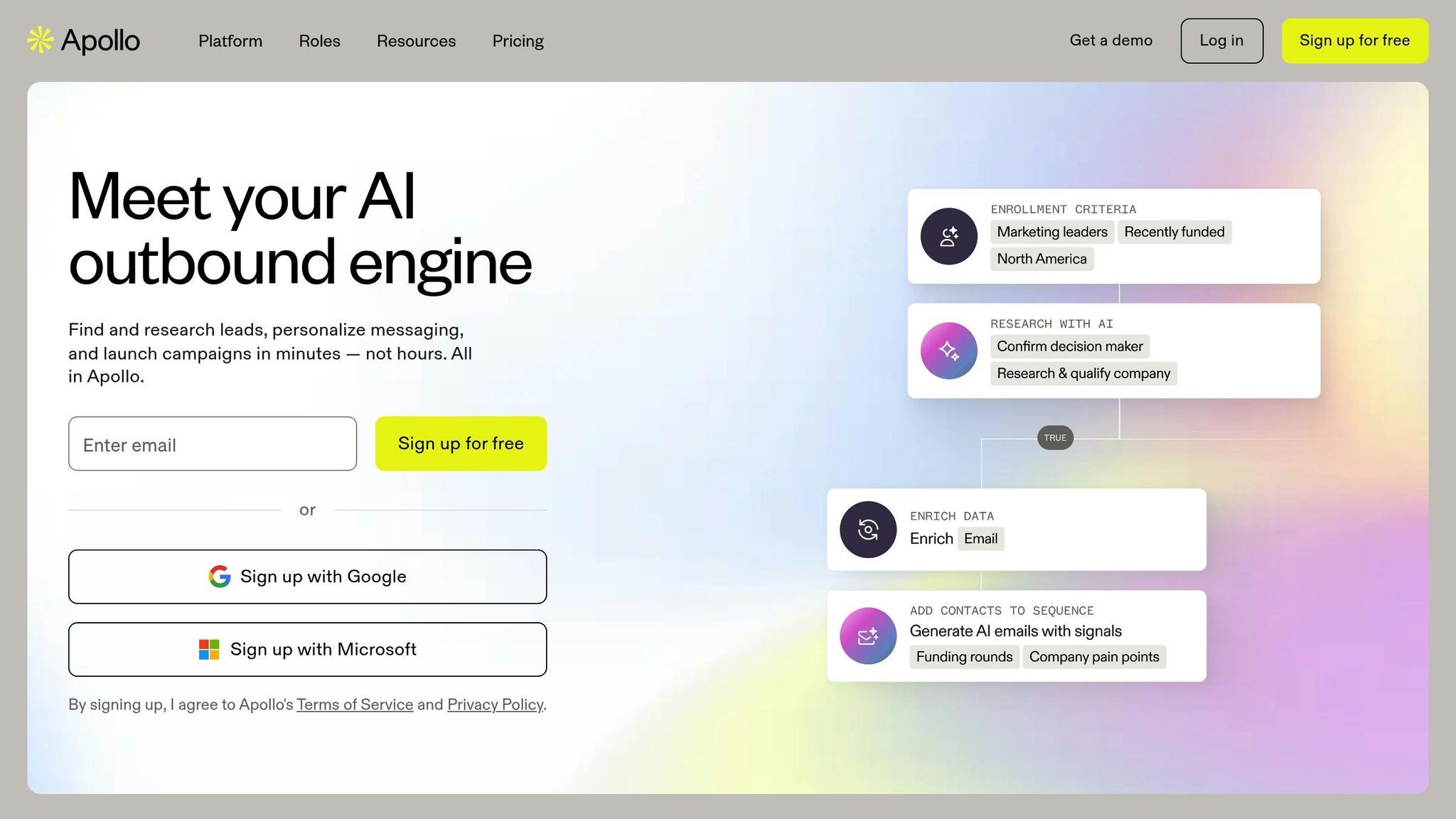
Apollo.io is an all-in-one AI sales platform designed to revolutionize how sales teams handle competitive intelligence. By combining prospecting, outreach, and data enrichment into a single tool, it simplifies workflows while providing access to a massive database of over 210 million contacts and 30 million companies. This ensures that sales teams always have access to accurate, up-to-date information [9].
One of Apollo.io's standout features is its ability to track competitors' key personnel, hiring trends, and organizational changes. It also monitors when prospects interact with competitors, offering a unique edge in understanding the competitive landscape.
Key Features for Competitive Intelligence
Apollo.io equips sales teams with advanced filtering tools to pinpoint prospects within specific market segments, making it easier to analyze competitors and uncover new opportunities. Its AI-powered search helps identify companies that might be exploring similar solutions, giving sales teams an advantage in positioning their offerings.
The platform's data enrichment capabilities eliminate the need for manual research by delivering real-time updates on market changes and competitor actions. This allows teams to adapt their strategies proactively based on the latest insights.
Apollo.io also integrates competitive intelligence directly into its outreach automation tools. Sales teams can tailor their messaging to reflect competitive scenarios, and the platform tracks engagement patterns to reveal which messages resonate most effectively with different prospects.
Pricing (in USD)
While Apollo.io doesn't publicly disclose its pricing tiers, it’s known for consolidating multiple sales functions into a single solution, leading to substantial cost savings. For example, Census reported a 64% reduction in platform costs while gaining access to four times more contact data. Similarly, Predictable Revenue cut costs by 50%, doubled their email open rates, and significantly reduced the time it took to schedule meetings [9].
Integrations with Sales and Marketing Tools
Apollo.io integrates seamlessly with major CRMs like Salesforce and HubSpot, ensuring smooth data synchronization across platforms. It connects contact details, activity logs, and outreach campaigns, creating a unified ecosystem that keeps all sales data clean and up to date. This integration ensures that workflows remain efficient and uninterrupted.
Benefits for U.S.-Based Sales Teams
For sales teams in the U.S., Apollo.io’s extensive database provides deep insights into American businesses, helping track competitor activities and uncover new market opportunities.
Mark Turner, VP of Revenue Operations at Built In, highlights the platform's effectiveness:
"Apollo enriches everything we have: contacts, leads, accounts. We don't really have to touch it, it just works."
Other success stories include Cyera, which increased booked meetings by 75% while cutting manual work in half, and Arbolus, which achieved notable improvements in workflow efficiency. With over 500,000 companies using Apollo.io, it’s become a trusted choice for sales teams looking to streamline their competitive intelligence efforts [9].
sbb-itb-4c49dbd
7. ZoomInfo
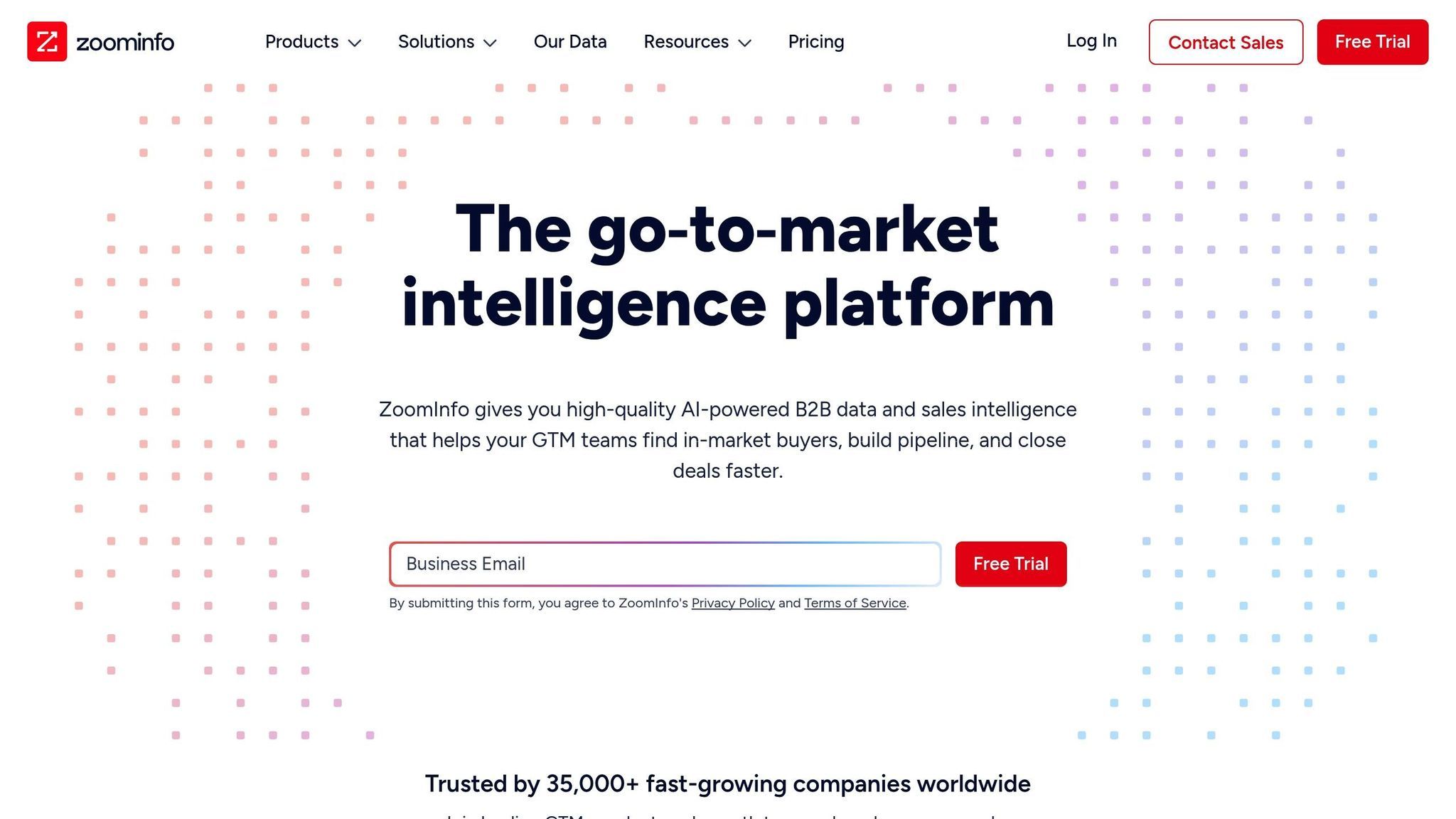
ZoomInfo is a B2B intelligence platform that combines extensive contact and company data with tools for competitive intelligence. Designed for sales teams, it integrates lead generation, prospecting, and competitor tracking into one solution.
A standout feature of ZoomInfo is its real-time data updates, supported by one of the largest databases of U.S. businesses. This makes it an essential resource for sales teams looking to outpace competitors and effectively target American markets.
Key Features for Competitive Intelligence
ZoomInfo specializes in tracking buyer intent, monitoring competitors, and analyzing market trends. It keeps tabs on company news, funding updates, executive changes, and product launches, all accessible through customizable dashboards and automated alerts [1].
One of its most valuable tools is the buyer intent signals feature, which identifies when prospects are researching solutions, including those offered by competitors. This allows sales teams to time their outreach perfectly and tailor their messaging to address specific needs.
The platform also excels in competitor tracking by analyzing company hierarchies, following decision-maker movements, and detecting changes in market positioning. Additionally, it compiles industry signals to help sales teams identify broader market trends and adapt their strategies effectively [1]. These capabilities make it a strong choice for competitive intelligence.
Pricing (in USD)
ZoomInfo employs a custom pricing model based on factors like team size, required features, and integration needs. Although specific prices aren't disclosed, U.S. businesses typically spend anywhere from several hundred to several thousand dollars per month. This investment often delivers significant returns, as companies using platforms like ZoomInfo report a 49% increase in win rates and faster deal closures compared to teams without such tools [10].
Integrations with Sales and Marketing Tools
The platform integrates smoothly with popular tools like Salesforce, HubSpot, Marketo, Outreach, and Microsoft Dynamics. These integrations allow for automatic data enrichment, CRM updates, and streamlined management of outreach campaigns [1]. With these features, sales teams can access critical insights - such as buyer intent data and competitor intelligence - without juggling multiple tools, simplifying their workflow and boosting efficiency.
Benefits for U.S.-Based Sales Teams
ZoomInfo offers distinct advantages for American sales teams, including compliance with U.S. standards and a deep focus on U.S. businesses. This localized approach helps domestic teams improve lead targeting, shorten sales cycles, and gain actionable insights into competitors in the American market [1].
For example, a U.S.-based technology company used ZoomInfo to monitor competitor product launches and detect shifts in buyer intent within their target audience. By leveraging the platform’s intent data and competitor tracking tools, the sales team refined their messaging and sped up their closing process. The result? Higher win rates and shorter sales cycles [1]. These insights are invaluable for sharpening competitive strategies and achieving sales goals faster.
8. Similarweb
Similarweb provides a powerful way to dive into digital intelligence by analyzing website performance, traffic sources, and audience engagement. It helps businesses uncover competitors' online strategies, moving beyond just tracking company news or product updates. Instead, it delivers detailed insights into how websites perform, where competitors get their traffic, and how they connect with their audience.
By turning website analytics into actionable insights, Similarweb equips sales teams to identify the marketing channels fueling their competitors' leads, pinpoint trending keywords in their industry, and measure their own digital performance against top players in the market.
Key Features for Competitive Intelligence
Similarweb's traffic analysis offers a clear breakdown of competitors' traffic sources, including direct visits, search engines, social media, and paid advertising. Its audience insights reveal data like geographic location, interests, and online behavior patterns of competitors' website visitors - helping sales teams create more personalized outreach strategies.
The platform also supports competitor benchmarking with easy-to-read charts and market share overviews. Its keyword research tool highlights search terms driving traffic to competitors, while the industry trends feature helps businesses identify market shifts early, giving them a competitive edge.
Pricing (in USD)
Similarweb offers both free and paid plans to accommodate different budgets. The free version provides limited access to traffic and engagement data, suitable for basic research. Paid plans start at around $199 per month for entry-level features, with higher tiers unlocking advanced analytics. Businesses often see a quick return on this investment, as companies using tools like Similarweb report 49% higher win rates and faster deal cycles when competitive intelligence is integrated into their sales processes[10].
Integrations with Sales and Marketing Tools
The platform seamlessly connects with popular tools like Salesforce, HubSpot, and other CRM and marketing automation platforms. These integrations allow sales teams to access real-time competitive intelligence directly within their workflows. For example, competitor website performance data can be automatically pulled into CRM systems, ensuring account managers have up-to-date insights when preparing for client meetings. This integration streamlines the process, helping teams make smarter, data-driven decisions.
Benefits for U.S.-Based Sales Teams
For sales teams in the U.S., Similarweb provides tailored insights into local digital behaviors. Features like market share snapshots, detailed breakdowns of traffic channels, and polished visualizations make it easier to respond to competitor activity and adapt to market trends. This is especially valuable in industries like SaaS, e-commerce, and B2B services, where digital strategies play a critical role in success.
9. Meltwater
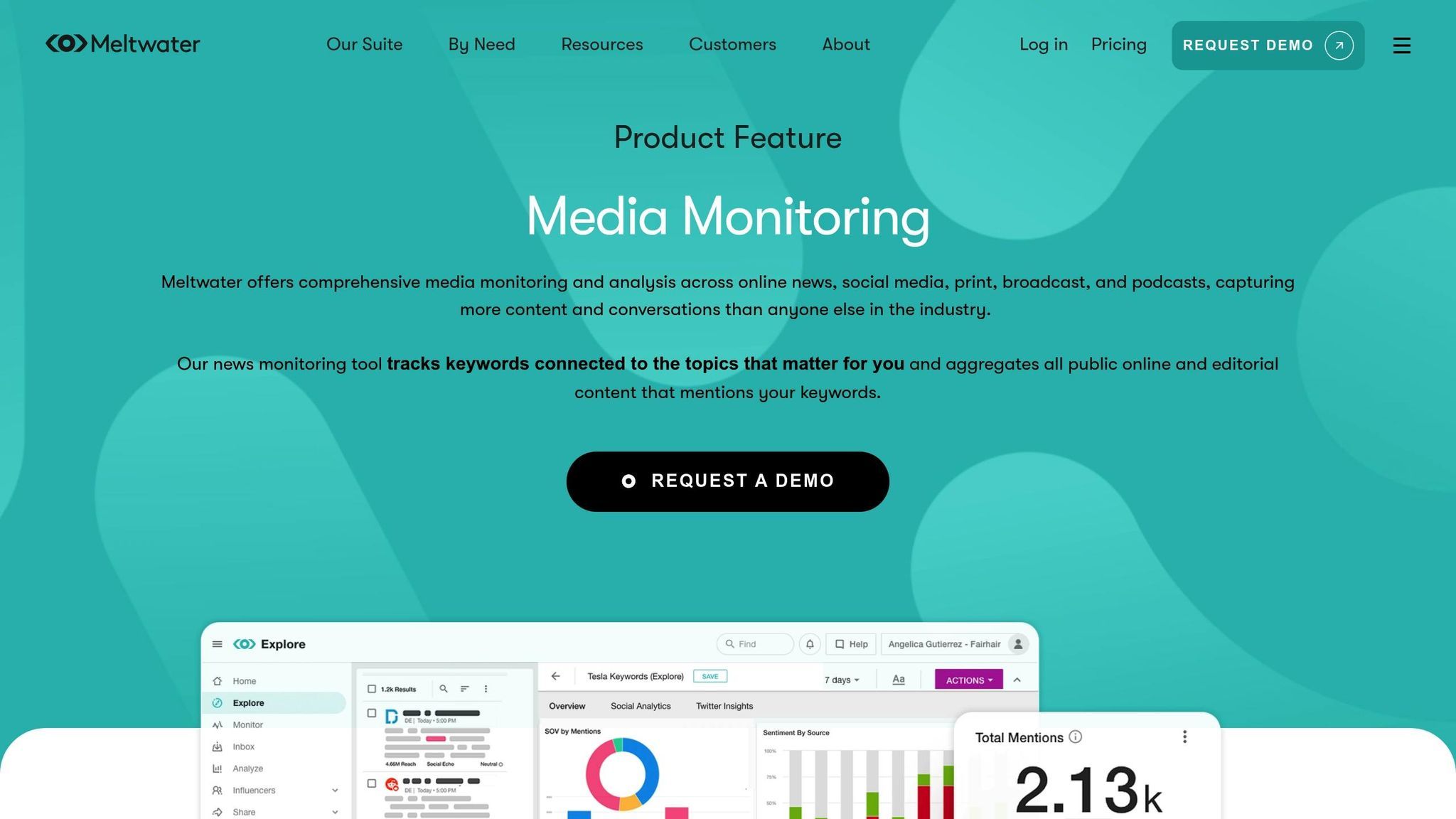
Meltwater is a media monitoring and social listening platform designed to track over 270,000 news sources and analyze more than 500 million social media posts daily[1]. This allows sales teams to react quickly to competitor activities, industry trends, and shifts in customer sentiment.
By pulling data from a variety of sources - news outlets, blogs, and social media - Meltwater provides actionable insights that fuel competitive intelligence efforts. This extensive data collection underpins all of the platform’s features.
Key Features for Competitive Intelligence
Meltwater stands out for its broad coverage of media and social data. Its AI-powered tools deliver insights like sentiment analysis, share of voice metrics, and trend identification. These features help sales teams not only track competitor actions but also understand how the market is responding to them[7]. Customizable dashboards make it easy to focus on the most relevant information while filtering out unnecessary noise.
The platform also offers automated alerts for competitor mentions, product launches, or key industry terms. These notifications ensure teams stay on top of market changes, with machine learning algorithms fine-tuning the alerts to reduce false positives and deliver the most impactful updates[7].
To simplify decision-making, Meltwater provides visual reporting tools that turn complex data into clear charts and graphs. These visuals help sales teams monitor competitor media coverage, track public sentiment changes, and compare their own share of voice against competitors.
Pricing (in USD)
Meltwater uses a custom pricing structure based on factors like business size, number of users, and selected features. Entry-level packages range from $4,000 to $6,000 annually, while enterprise solutions can cost over $20,000 per year[1].
The investment often justifies itself, as companies using Meltwater report measurable improvements in sales outcomes. For instance, businesses have seen up to a 25% reduction in sales cycle time and a 15% boost in win rates, thanks to better market awareness and quicker responses to competitor actions[1].
Integrations with Sales and Marketing Tools
Meltwater integrates seamlessly with popular CRM and marketing platforms like Salesforce, HubSpot, Marketo, Slack, and Microsoft Teams[7]. For example, when the platform detects a competitor announcement, it can automatically create a task in Salesforce or send an alert to specific Slack channels. This ensures competitive intelligence is woven into daily sales workflows.
Benefits for U.S.-Based Sales Teams
U.S.-based sales teams gain additional advantages from Meltwater’s localized data collection and analysis. The platform provides extensive monitoring of American media outlets and adheres to U.S. data privacy standards, offering reliable and compliant intelligence gathering[7].
One standout example involves a U.S. SaaS company that leveraged Meltwater to track competitor product launches and customer feedback on social media and news outlets. By setting up automated alerts for competitor activities, the sales team was able to address objections during discussions and adjust their pitch based on real-time market sentiment. This approach led to a 15% increase in win rates over six months[7].
A notable example involves a U.S. SaaS company that used Meltwater to monitor competitor product launches and customer feedback across social media and news outlets. By setting up automated alerts for key competitor activities, the sales team proactively addressed objections during conversations and adjusted their pitch based on real-time market sentiment - resulting in a 15% increase in win rates over six months[7].
Meltwater also helps U.S. sales teams tailor their messaging by identifying regional market trends and benchmarking against domestic competitors. These insights support more effective sales strategies and contribute to shorter deal cycles in the competitive U.S. market.
10. Owler Max
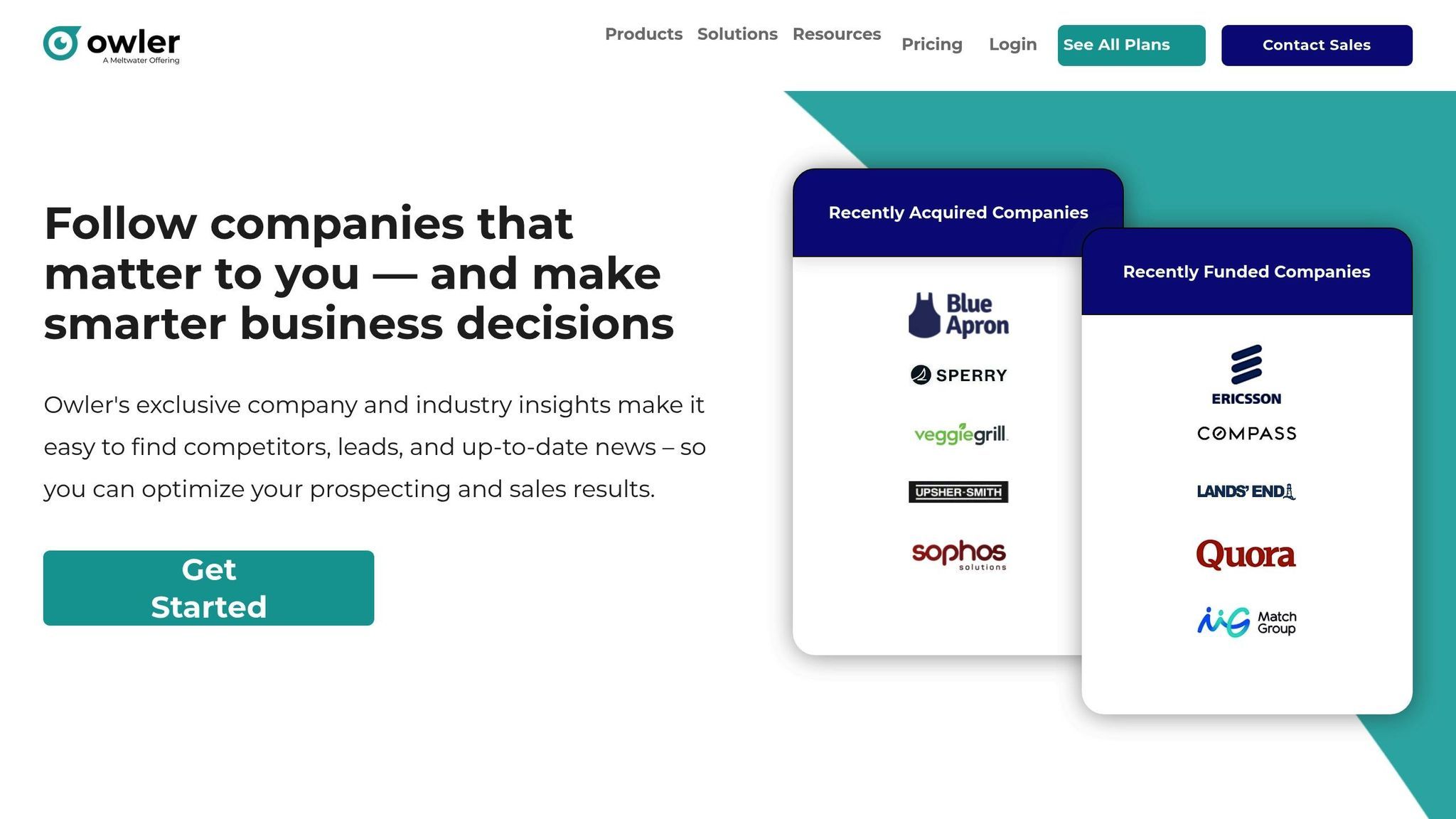
Owler Max is a competitive intelligence platform that tracks over 15 million companies worldwide, offering real-time updates on both private and public businesses [1]. It helps sales teams stay informed about competitor activities such as funding announcements, acquisitions, leadership shifts, and product launches - key factors that can influence sales strategies.
What makes Owler Max stand out is its ability to monitor companies at every stage of growth, from startups to well-established corporations. This extensive reach ensures that sales teams can keep tabs on competitors of all sizes, which is particularly valuable in the B2B sales landscape.
Here’s a closer look at what Owler Max brings to the table.
Key Features for Competitive Intelligence
Owler Max is built around four main capabilities: company profiles, competitor tracking, news alerts, and relationship mapping. The company profiles deliver detailed insights into target businesses, including financial data and employee headcounts. With competitor tracking, users get automated updates on critical changes like funding rounds, acquisitions, and leadership transitions. The platform’s real-time alerts notify users of major news events as they happen, while relationship mapping highlights connections between companies and executives, helping teams identify potential warm introductions.
Pricing (in USD)
Owler Max operates on a subscription model, with pricing available upon request. While exact costs aren’t always publicly disclosed, industry reports suggest plans typically start in the hundreds of dollars per user annually. Enterprise-level plans are available for larger teams, and the platform offers flexible billing options, including monthly or yearly payments, tailored to team size and feature needs.
Integrations with Sales and Marketing Tools
Owler Max integrates seamlessly with widely-used CRM systems and sales tools like Salesforce, HubSpot, and Slack. These integrations make it easier to embed competitive intelligence into everyday workflows. For instance, the Salesforce integration displays competitive alerts directly within opportunity records, giving sales reps timely insights. Similarly, the Slack integration sends automated updates to team channels whenever competitors make notable moves.
Benefits for U.S.-Based Sales Teams
For sales teams in the U.S., Owler Max provides strong coverage of North American companies and aligns well with local business norms [1]. The platform’s real-time alerts, rich company data, and relationship mapping tools help teams anticipate competitor actions, refine outreach strategies, and boost win rates. One example: a U.S.-based SaaS sales team used the platform to monitor a competitor’s product launch and leadership changes. By leveraging relationship mapping, they identified mutual connections and secured warm introductions, ultimately increasing their closed deals by 20% in one quarter [1]. Owler Max equips U.S. sales teams with actionable insights to maintain a competitive edge in their markets.
Tool Comparison Chart
Below is a streamlined chart comparing key features, pricing, and integrations for competitive intelligence tools. These options are designed to help U.S. sales teams gain timely insights and maintain an edge in the market.
| Tool | Key Features | Starting Price (USD) | Primary Integrations | Advantages for U.S. Sales Teams |
|---|---|---|---|---|
| Insightsfirst | AI-powered research, market disruption alerts, predictive analytics | Custom quote | Salesforce, HubSpot, analytics platforms | Delivers proactive insights and supports data-driven strategies |
| Kompyte | Real-time competitor tracking, automated alerts, website monitoring | Custom quote | Salesforce, Slack, marketing automation tools | Enables quick responses to competitor activities with automated intelligence |
| Crayon | Dynamic battlecards, win/loss analysis, AI-generated insights, content analytics | Custom quote | Salesforce, Slack, Highspot, Gong | Offers seamless CRM integration and robust competitive intelligence tools |
| Brandwatch | Social listening, brand sentiment analysis, competitor social monitoring | Custom quote | Social media platforms, CRM systems, analytics tools | Tracks brand reputation and market sentiment comprehensively |
| Highspot | Sales enablement, content management, AI coaching, conversation intelligence | Custom quote | Over 100 platforms (e.g., Salesforce, Microsoft, Google) | Combines sales enablement with AI-driven coaching for enhanced performance |
| Apollo.io | Lead generation, email automation, contact database, sales analytics | $49/month per user | Major CRMs, marketing automation platforms | Affordable option with strong automation and prospecting capabilities |
| ZoomInfo | B2B contact data, buyer intent signals, automated workflows, company intelligence | Custom quote | Salesforce, HubSpot, marketing automation tools | Provides extensive U.S. company data and AI-driven insights |
| Similarweb | Website traffic analysis, audience insights, competitor benchmarking, digital intelligence | $167/month (Pro plan) | Google Analytics, CRM systems, marketing platforms | Offers digital market intelligence with clear pricing options |
| Meltwater | Media monitoring, social analytics, news tracking, PR intelligence | Custom quote | Social platforms, CRM systems, analytics tools | Delivers in-depth media coverage and tracks social trends effectively |
| Owler Max | Company profiles, news alerts, relationship mapping | $99/month per user | CRM systems, sales tools | Provides detailed profiles and alerts for public and private companies |
This chart simplifies the decision-making process, letting you quickly identify tools that align with your team’s priorities without digging through lengthy reviews.
Key Takeaways for U.S. Sales Teams
Pricing Models: Tools generally fall into two categories - monthly subscription plans, like Apollo.io and Similarweb, or custom enterprise quotes tailored to larger teams needing advanced features.
AI-Driven Insights: Insightsfirst, Crayon, and ZoomInfo stand out for their use of AI in predictive analytics and buyer intent signals. Highspot also uses machine learning to improve sales coaching and content recommendations.
CRM Integrations: Tools like Crayon and ZoomInfo integrate directly with platforms like Salesforce, ensuring competitive intelligence is readily accessible within your existing systems.
Affordable Options: For smaller teams, Apollo.io and Owler Max offer budget-friendly pricing while still delivering valuable features like lead generation and detailed company profiles.
For even more options, U.S. sales teams can explore AI SDR Shop, which offers comparisons of over 80 AI-powered SDR agents to enhance prospecting and sales enablement.
Conclusion
In today's fast-moving market, competitive intelligence tools have become indispensable for U.S. sales teams aiming to stay ahead. These platforms help sales professionals benchmark their performance, analyze competitors, and make smarter, data-driven decisions that directly influence win rates and revenue growth [1]. Beyond immediate benefits, they pave the way for more strategic, long-term advantages.
The real power of these tools lies in their ability to shift sales efforts from reactive to proactive. By using competitive intelligence, teams can anticipate market trends and competitor strategies, allowing them to craft precise messaging and speed up sales cycles.
Modern AI-powered platforms take this a step further. They combine real-time monitoring with machine learning analytics to deliver insights that fuel revenue operations and go-to-market strategies [3]. Features like automated competitor tracking, battlecard creation, and seamless CRM integration ensure these insights are delivered right into daily workflows [1].
Integrating competitive intelligence tools with platforms like Salesforce or HubSpot is a game-changer. It simplifies workflows and fosters a culture of informed decision-making and constant improvement [5].
For teams looking to amplify their competitive edge, AI SDR Shop offers a unique solution. With more than 80 AI-driven SDR agents, the platform automates tasks like lead discovery, enrichment, and outreach. By leveraging real-time data and intent signals, it creates hyper-personalized messaging that resonates with prospects.
Choosing the right competitive intelligence tools is critical. Whether you go for enterprise solutions like Crayon and ZoomInfo or more budget-friendly options like Apollo.io and Owler Max, integrating these tools into your workflow can drive higher win rates, shorten sales cycles, and enable strategic, measurable growth.
FAQs
How do competitive intelligence tools like Insightsfirst and Kompyte work with CRM systems to improve sales processes?
Competitive intelligence tools like Insightsfirst and Kompyte work seamlessly with CRM systems to simplify and improve sales processes. These tools collect and analyze real-time data on market trends, competitor moves, and customer behavior, syncing this valuable information directly into your CRM. This integration ensures your sales team has access to actionable insights within the tools they already rely on every day. By connecting with CRMs, these tools automate tasks such as monitoring competitor updates, spotting emerging market trends, and creating detailed reports. This not only cuts down on time-consuming manual work but also empowers sales teams to make smarter decisions, focus on high-priority leads, and fine-tune their strategies to outpace competitors.
What should sales teams consider when deciding between custom pricing and subscription plans for competitive intelligence tools?
When deciding between custom pricing models and subscription plans for competitive intelligence tools, sales teams should weigh their budget, scalability needs, and usage patterns carefully. Custom pricing can be a great fit for businesses with specific needs or larger teams, as it offers tailored solutions to match unique requirements. On the flip side, subscription plans provide predictable costs, making them a solid choice for smaller teams or those with more standard demands. Key considerations include the features offered, the level of support available, and how well the plan integrates with your existing tools. Additionally, think about the long-term value and flexibility of the pricing model to ensure it supports your sales objectives and future growth plans.
How can U.S.-based sales teams use tools like ZoomInfo and Meltwater to analyze market trends and boost sales performance?
U.S.-based sales teams have powerful tools at their disposal, like ZoomInfo and Meltwater, to sharpen their strategies and stay ahead in local markets. ZoomInfo stands out by offering detailed company profiles and contact data, making it easier to spot promising leads and personalize outreach efforts. Meanwhile, Meltwater focuses on media monitoring and social listening, allowing teams to keep tabs on industry updates, competitor moves, and customer sentiment - all in real time. When these tools are woven into daily workflows, they empower teams to make smarter, data-backed decisions, fine-tune their messaging, and boost their success rates. To take things a step further, combining them with AI-driven tools, like those featured on AI SDR Shop, can simplify lead generation and engagement, saving time and enhancing results.